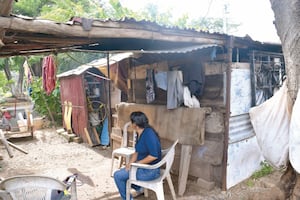Más Información

Marco Rubio destaca labor de seguridad de México; "están haciendo más que nunca en su historia", afirma

Sin garras y con lesiones Profepa rescata a león amarrado a un árbol en Nayarit; inician investigación

Inegi oficializa creación de nueva instancia para medir la pobreza, tras desaparición del Coneval; crea una Dirección General

Juez frena revocación de testigo protegido a Raúl Rocha; da medida cautelar a dueño de Miss Universo
You might probably have tried pasties, best known as “ pastes ” in Mexico’s Hidalgo state. Traditional pasties have a braid on the edge, which was used so that miners could hold them without getting it dirty when eating them; once they finished it, they threw away the braid that was already covered with dirt.
This and other fun facts can be found at the Paste Museum that opened its doors in 2012 at Real del Monte, Hidalgo. Here, visitors can create their own snack and see the old kitchens where they were prepared, as well as exhibition halls with the region’s historical mining information.
The museum is located at Real del Monte, the place of origin of pasties, a cold-weather place with cobbled streets and red roofs with English style architecture fronts.

Recommended:
This area was inhabited by English people for industrial means and they also left behind their gastronomy and other cultural characteristics. Real del Monte was known for the exploitation of silver mines by the Spanish and English for 500 years when it was was the first in the world on mining exports during the early 19th century.
From 1824 to 1849, this place stood out for its English traditions, including pasties, an iconic dish of miners in Cornwall.
At first, they called it by its original name “pasty” and it was filled with raw chopped beef; nevertheless, Mexican miners started calling it paste since the pronunciation was difficult for them.
They also changed the fillings; instead of meat, they added beans, potatoes, chili peppers, and vegetables, among other national ingredients and they added the braid on the edge to make it easier to eat the pastes .
This snack has been industrialized and there are few people who still make them the traditional way in domestic ovens and with lard. Usually, modern pastes that have become popular throughout the country, are now prepared with butter and without the braid, so they could easily lose their title as “pastes” and become mere pasties.
In this regard, Marìa Fernanda Rodrìguez said that she has prepared this food for over 10 years but her “paste-making grandmother” – as she calls her – has made them for over 25 years; back then, there were five shops that sold pastes in Real del Monte; now, there are over 20,

She stressed that industrialized pastes do not have the same taste as traditional ones since the fillings are pre-cooked and the dough is different than the traditional one “which have a special recipe we inherited from our grandparents,” she said with a smile.
Recommended:
She said that the best-selling traditional pasties are the ones filled with potatoes and beef which have a braid on the side, and those of pork sausage and beans, which have a braid on the top, “the dough we use is not as puffy and is harder.”
María Fernanda makes 240 units on the weekends when sales are higher, and when they are low, she makes around 50. She adds that competition from big industries is due to pastes being sold cheaper. “It’s more about competition than flavor, but they don’t taste the same everywhere.”
She explained that time and big industries have make pastes sales lower, however, she asserts she keel carry on with the tradition because she loves it and this is how she provides for her family.
Meanwhile, Rodolfo Silva, who is 62 years old, has been making pastes for 22 years in Real del Monte. He also says sales have been low for five years due to the great industrial competition. With time, the costs have increased and now it goes from MXN $12 to $15.
He mentioned that tourists prefer to go to luxurious shops even though pasties there are industrialized and are not original. “They are made with lard, vegetable fat, and salt, but big firms – that make them with butter – have caused sales to favor commercial pastes . I used to sell 200, now, I can barely sell 30.”
José Zamora, a Paste Museum guide, informed that there are only five small shops that make traditional pastes in Real del Monte: Real de Plateros, El Villar, La Góndola, Márquez, and Los Portales.
These family shops were the pioneers in the proliferation of pastes since, in 1980 when sales were bad in Real del Monte, they went to Pachuca with their small baskets and this the commercialization of this food began taking place in the rest of the country.
Noticias según tus intereses
[Publicidad]
[Publicidad]










